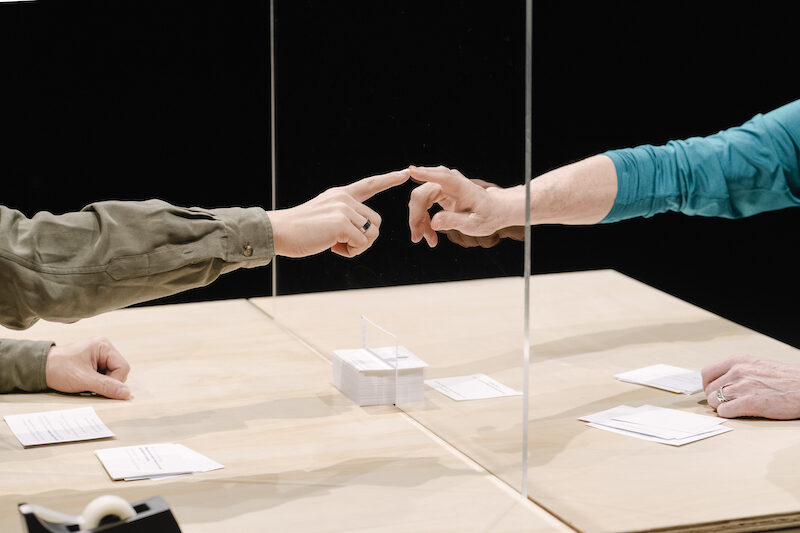Nod When You’ve Got It
Review of A Thousand Ways (Part Two): An Encounter, presented by On the Boards
Written by Teen Writer Kyle Gerstel and edited by Teen Editor Lily Williamson

“The truth is rarely pure and never simple.” - Oscar Wilde
A man sits alone in a barren theater, awaiting my arrival. Upon the table before him lies a stack of index cards bursting with inquiries and fantasies to guide participants, a script to be performed for no one but one another. I take a seat.
A Thousand Ways (Part Two): An Encounter at On the Boards builds upon the shared language established in Part One: A Phone Call to explore how we engage with each other in shared space. In my interview with Michael Silverstone, co-creator of the A Thousand Ways triptych, he told me that with this piece, “We’re back to the problem we had before the pandemic.”
While A Phone Call thrived on the safety ingrained in audience members’ anonymity, An Encounter challenges participants to interact just as vulnerably without that layer of protection. The result is an engrossing scripted experience that “picks at the same question in a completely different mode,” as co-creator Abigail Browde put it.
Oftentimes, as in A Phone Call, the most seemingly basic questions prompted the most intriguing reactions. For instance, one index card listed a series of yes-or-no questions for me to ask, such as:
“Have you gone fishing?”
“Yes,” replied the man.
“Have you gone hunting?”
“Yes.”
“Have you served in the military?”
A pause. He sighed.
“Yes.”
Why did he sigh? Does he have PTSD? Or am I simply overthinking this? That type of idiosyncratic behavior engaged my imagination as we constantly reassessed one another, just as we do in our day-to-day lives. As Silverstone explained, “You’re a stranger and I don’t know anything about you, so I’m going to make all these assumptions and construct a narrative from the moment we sit down together.”
The unique relationship between audience members that develops over the course of the piece begs the question: is theater about what occurs on stage or in the auditorium? Before experiencing A Thousand Ways, I thought theater had to be a one-sided medium where there is a distinction between performers and audience members, but after witnessing the deceiving simplicity of An Encounter, I believe that the act of creation as a shared experience is what makes the medium so invigorating.
Suddenly, an index card forced me to take a pack of cards and leave (a sentence I never thought I’d be typing). “It felt more important to break the bond in order to bring the bonding into focus,” said Silverstone. Browde continued, “It seemed like if people left the theater together, it’d ask them to revert their way of talking to one another and would remove some of the power of the piece.” When I asked the theatermakers what they wanted audiences to walk away from the show with, they passionately passed. Why? As Browde put it, “It’s not our job to have them leave with specific takeaways.” Silverstone continued, “It’s not open because we don’t know how to make something more specific, it’s just that we don’t want to.”
As I left On The Boards, I opened the pack of cards, which followed a similar process of constructing narratives about a stranger in the distance. By completing the experience outside the theater, An Encounter shifts the way audience members perceive others in their daily environment without demanding a specific point of view, and isn’t that what art is all about?
A Thousand Ways (Part Two): An Encounter was presented by On the Boards and all future performances are temporarily postponed. For more information see here.
Lead photo credit: On the Boards. Photo by Everything Time Studio.
The TeenTix Newsroom is a group of teen writers led by the Teen Editorial Staff. For each review, Newsroom writers work individually with a teen editor to polish their writing for publication. The Teen Editorial Staff is made up of 6 teens who curate the review portion of the TeenTix blog. More information about the Teen Editorial Staff can be found HERE.
The TeenTix Press Corps promotes critical thinking, communication, and information literacy through criticism and journalism practice for teens. For more information about the Press Corps program see HERE.


